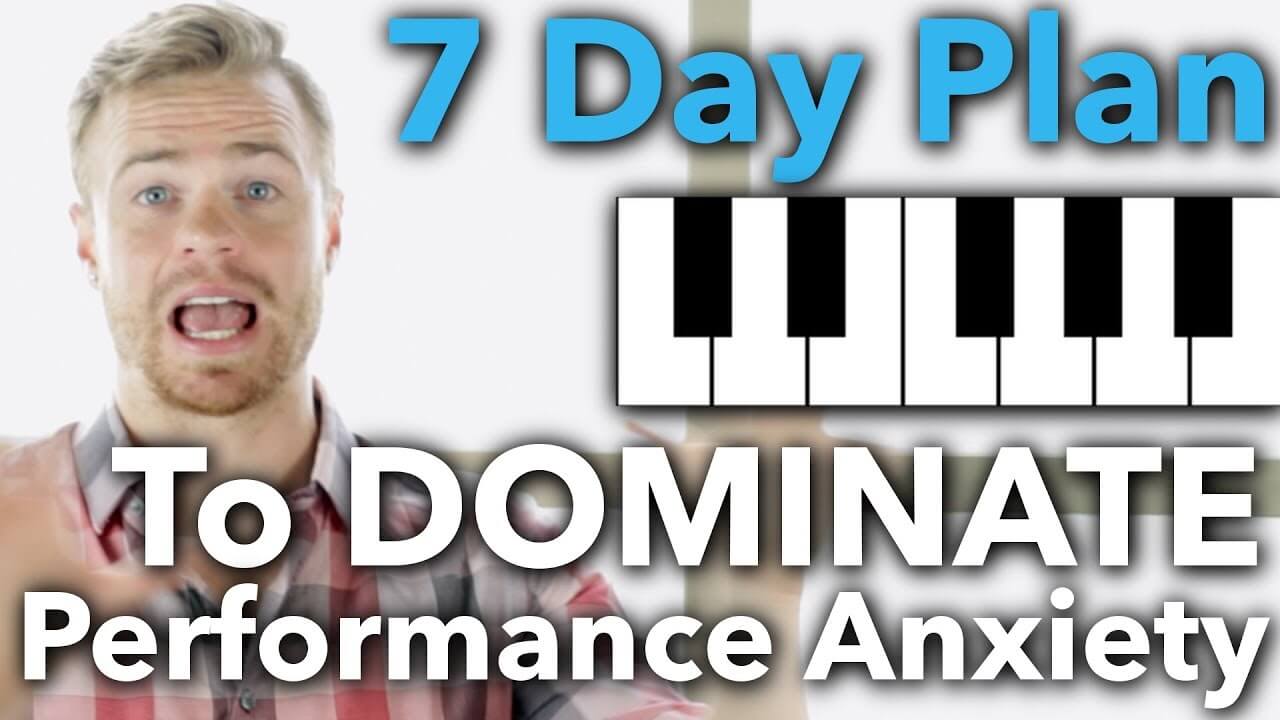Piano performance anxiety is completely normal, I even continued to have it years after my first performance, but it can be minimized with the right preparation. In this blog post you’re going to learn about a 7 day step-by-step plan that includes my five “gauntlet exercises” you can use to reduce performance anxiety.
One thing I realized as I had more and more piano performances is that there is a difference between having a piano piece learned and having it rock-solid and performance ready. I used to practice my piece over and over again and while I could get it in my practice room just fine, it was nowhere near being performance ready. The piece needed to be worked on in multiple ways and from multiple angles so I had a complete grasp of it.
I’ve got a weird metaphor for you to think about this process, but it’s helpful for understanding why the practice process I’m going to tell you about is so valuable.
Imagine the piece you want to play is a giant rock hanging by a string from the ceiling. If you only try to learn your piece by repeating it a bunch of times, you literally have just one string holding that giant rock. And maybe that string can hold the rock, but when you get performance anxiety – when you’re nervous, hands are a little sweaty, the keyboard is different than the one you’re used to – that one string is going to snap and your rock is going to come tumbling down.
When you practice your piece by running it through the gauntlet, learning your song in a variety of ways, it’s like attaching a bunch of different strings to that rock and frickin duct taping it to the ceiling, so even if a couple of those strings snap, your rock is still held up by all of those other forms of memory you’ve used to learn your piece.
Alright, so let’s get into the nuts and bolts of this process, go through the gauntlet exercises, and let you know what you can do in the 7 days leading up to your performance to minimize your anxiety.
The Gauntlet Exercises to Reduce Performance Anxiety
Let’s say you have a performance on Sunday, on Monday through Friday of that week you’re going to run your piece through gauntlet exercises. These are exercises I use all the time and they’re specifically designed to hit your piece from multiple angles.
Gauntlet Exercise #1 – Play the Entire Piece Hands Separate
I know, this sounds really easy, you may think that if you can already play your piece hands together then hands separate should be a piece of cake. What you realize, especially with the left hand, is that you don’t actually know the left hand part – you kind of just use muscle memory and follow along with the right hand.
What you want to do is play the entire piece with just your left hand and whenever you get to that part where you literally don’t know that next note, go back to the music, and really run through that left hand alone until you actually know the notes using your left hand, where you’re not just relying on the muscle memory.
Then, do the same thing with your right hand, running through the entire piece with just your right hand and going through those parts you get stuck on.
Gauntlet Exercise #2 – SUPER Slow Mo Practice
This is a strategy I got from Sergei Rachmaninoff, who supposedly did this before every big performance. What you do is turn your metronome down so slow that it’s actually harder to play. This is another drill where you can’t just use your muscle memory, as your fingers are used to playing at a faster speed, so you really have to know exactly which notes you are playing.
As you’re playing your piece, if there is a part you get stuck on, go back through the part until you can play it super slow.
Gauntlet Exercise #3 – Added Measure Strategy
The added measure strategy is my personal favorite. Whenever I use this one, I wake up the next day and can feel my piece is at a new level of solidified.
What you do is take the first measure, and practice just the first measure. Then you take the first two measures, and practice just the first two measures. Then you take the first three measures, and practice just the first three measures. Then four. Then five. You practice each set until you get to the end. Yes, this will take a long time.
Next, you’ll start at the end. Play only the last measure. Then the last two measures. Then the last three measures. You’ll do this all the way back to the beginning of the piece.
If you have a super long song you might want to break it into big sections, like the first page you do added measure forward and backward, then the second page, and so on.
The reason this works so well is because in a performance if you do have a slip up, what you don’t want to do is say, oh I have a slip up and now I have to go all the way back to the beginning of the section because I can’t find my place.
By doing the added measure strategy you actually have to start at random parts in the song where it might not be the normal chorus or melody part. This makes it a lot harder, but then when you’re in a performance, even if you do have a slip up, you’ll be able to start right back on track without starting the whole piece over.
I will say, this strategy is a BEAST. This is very mentally challenging, takes a long time, but if you run your piece through this, I promise you will feel it and it’ll be so much more solid than if you’re just running through your piece start to finish a thousand times.
Gauntlet Exercise #4 – Mental Practice
Mental practice is way harder than it seems. For this exercise you literally sit down, visualize your keyboard, and then you visualize your hands playing the actual song on the keyboard.
This should be easy, but for some reason this has always been very challenging for me. You don’t have any inputs, any sound to guide you, any sight to find the next note, and there’s no muscle memory involved – you actually have to know the notes inside and out.
So give this one a shot, don’t get too frustrated, even if you don’t get it perfect where you exactly visualize every single note, it still helps a lot to solidify your song even more.
Gauntlet Exercise #5 – Analyze Your Entire Piece and Write in the Chords
For this final exercise you’ll have to know a little music theory. If you don’t already know music theory, learn music theory 🙂
You also might want to print off a different sheet music so it’s not so cluttered when you’re writing every single chord above it.
What this exercise does is it gives you another string holding up that rock of yours. It makes it easier to get to the next note if you happen to get stuck during a performance.
Performance Run Throughs
On top of the different gauntlet exercises, what you want to be doing 1-3 times per day is performance run throughs. There are two types:
- Live performance run throughs
- Practice performance run throughs
Live performance run throughs is where you play in front of a live audience – running through your piece at your church, in front of your mom, or even for your friends.
Practice or “simulated” performance run throughs are where you can’t find an audience, but you perform your music just like you would if it was an actual performance. You’ll literally walk out of your practice room, come back in, and do exactly what you would do if it was a real performance.
The most important thing to do with these performance run throughs is to treat them like an actual performance. So, if you mess up, you have to actually find your spot, work through it, and YOU CAN’T STOP! You have to treat it like there is a real audience out there.
Structuring Your Week Before a Performance
Alright, so how does this exactly look? How does this all fit together? Let me give you an example to work from.
Let’s say you have a performance on Sunday, here’s what your week could look like:
- Monday – Gauntlet exercise #5 and 3 simulated performance run throughs
- Tuesday – Gauntlet exercise #1 and 1 live performance run through in front of your mom
- Wednesday – Gauntlet exercise #2 and 1 live performance run through at your church
- Thursday – Gauntlet exercise #3 and 3 simulated performance run throughs
- Friday – Gauntlet exercise #4 and 1 performance run through in front of your siblings
- Saturday – All about building confidence! Slow practice so it’s comfortable, no performance run throughs or gauntlet exercises.
The Day of Your Performance
In our example we said your performance would be on a Sunday, so, on this day get to the venue 15 minutes early, do 10-15 minutes of a technique warm up like scales, and take 15-45 minutes to do the exact same thing as Saturday – build confidence.
Don’t do any performance run throughs the day of playing your piece! At this point you just want to build confidence and have yourself feeling good.
Also, once you’re done warming up and practicing, you’re done, don’t do any more practice. It’s easy to say you have 10 or 15 extra minutes and play your piece again, but what happens if you mess up? You don’t want to have the chance of breaking your confidence so at this point it’s best to just trust the work you’ve put in – you’re already ready to go.
After you’ve done your warm up all you’re going to do is chill until you get to about 10-15 minutes before you actually have to go on stage. I used to try to pump myself up and get super confident but what would happen is I’d have to maintain that confidence for an hour while I waited to go on stage. That’s hard to do! Instead, you should just relax before you’re going to get on stage until you get to about 10 minutes before you have to play.
Once you get to about 10 minutes before you’re going to play, you’ll now focus on state-shifting, ramping up, and getting your confidence level up. I go through this more in this video.
What I do before a performance is some slow breathing or meditation for a few minutes and then I get myself frickin jacked! I’ll jump around, shadow box and really get in the right mindset to dominate the piece I’m going to play. This isn’t for everyone, some people will just meditate before they play, and that’s fine too – figure out what works best for you.
Last Thing…
If you have one of those situations where you have a terrible performance, don’t beat yourself up! The more performances you do, the better you’ll get.
Remember, every piano player ever has some sort of horror story of when they completely botched their piece, I have tons of them, but it’s just part of the process of starting as a beginner piano player and advancing to that next level.
If you want to improve your skills and move to that next level quicker, check out my free piano course which shows you step-by-step how to improve.

